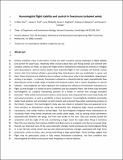| dc.contributor.author | Ravi, Sridhar | |
| dc.contributor.author | Crall, James Dewitt | |
| dc.contributor.author | McNeilly, Lucas | |
| dc.contributor.author | Gagliardi, Susan F | |
| dc.contributor.author | Biewener, Andrew Austin | |
| dc.contributor.author | Combes, Stacey A. | |
| dc.date.accessioned | 2015-04-13T21:08:31Z | |
| dc.date.issued | 2015 | |
| dc.identifier | Quick submit: 2015-03-10T11:07:47-04:00 | |
| dc.identifier.citation | Ravi, Sridhar, James D. Crall, Lucas McNeilly, Susan F. Gagliardi, Andrew A. Biewener, Stacey A. Combes. 2015. Hummingbord flight stability and control in freestream turbulent winds. The Journal of Experimental Biology 218: 1444-1452. | en_US |
| dc.identifier.issn | 0022-0949 | en_US |
| dc.identifier.uri | http://nrs.harvard.edu/urn-3:HUL.InstRepos:14422004 | |
| dc.description.abstract | Airflow conditions close to the Earth’s surface are often complex, posing challenges to flight stability and control for volant taxa. Relatively little is known about how well flying animals can contend with complex, adverse air flows, or about the flight-control mechanisms employed by animals to mitigate wind disturbances. Several recent studies have examined flight in the unsteady von Kármán vortex streets that form behind cylinders, generating flow disturbances that are predictable in space and time; these structures are relatively rare in nature, as they occur only in the immediate, downstream vicinity of an object. In contrast, freestream turbulence is characterized by rapid, unpredictable flow disturbances across a wide range of spatial and temporal scales, and is nearly ubiquitous in natural habitats. Hummingbirds are ideal organisms for studying the influence of freestream turbulence on flight, as they forage in a variety of aerial conditions and are powerful flyers. We filmed ruby-throated hummingbirds (A. colubris) maintaining position at a feeder in laminar and strongly turbulent (intensity ~15%) airflow environments within a wind tunnel, and compared their mean head, body, tail and wing kinematics, as well as variability in these parameters. Hummingbirds exhibited remarkably stable head position and orientation in both smooth and turbulent flow while maintaining position at the feeder. However, the hummingbird’s body was less stable in turbulent flow and appeared to be most sensitive to disturbances along the mediolateral axis, displaying large lateral accelerations, translations, and rolling motions during flight. The hummingbirds mitigated these disturbances by increasing mean wing stroke amplitude and stroke plane angle, and by varying these parameters asymmetrically between the wings, and from one stroke to the next. They also actively varied the orientation and fan angle of the tail, maintaining a larger mean fan angle when flying in turbulent flow; this may improve their passive stability, but likely incurs an energetic cost due to increased drag. Overall, we observed many of the same kinematic changes noted previously for hummingbirds flying in a von Kármán vortex street, but we also observed kinematic changes associated with high force production, similar to those seen during load-lifting or high-speed flight. These findings suggest that flight may be particularly costly in fully mixed, freestream turbulence, the flow condition that hummingbirds are likely to encounter most frequently in natural habitats. | en_US |
| dc.description.sponsorship | Organismic and Evolutionary Biology | en_US |
| dc.language.iso | en_US | en_US |
| dc.publisher | Company of Biologists | en_US |
| dc.relation.isversionof | doi:10.1242/jeb.114553 | en_US |
| dash.license | OAP | |
| dc.title | Hummingbird flight stability and control in freestream turbulent winds. | en_US |
| dc.type | Journal Article | en_US |
| dc.date.updated | 2015-03-10T15:07:48Z | |
| dc.description.version | Accepted Manuscript | en_US |
| dc.rights.holder | Sridhar Ravi, James D. Crall, Lucas McNeilly, Susan F. Gagliardi, Andrew A. Biewener and Stacey A. Combes | |
| dc.relation.journal | Journal of Experimental Biology | en_US |
| dash.depositing.author | Biewener, Andrew Austin | |
| dc.date.available | 2015-04-13T21:08:31Z | |
| dc.identifier.doi | 10.1242/jeb.114553 | * |
| dash.contributor.affiliated | Gagliardi, Susan F | |
| dash.contributor.affiliated | Combes, Stacey A. | |
| dash.contributor.affiliated | Crall, James | |
| dash.contributor.affiliated | Biewener, Andrew | |


